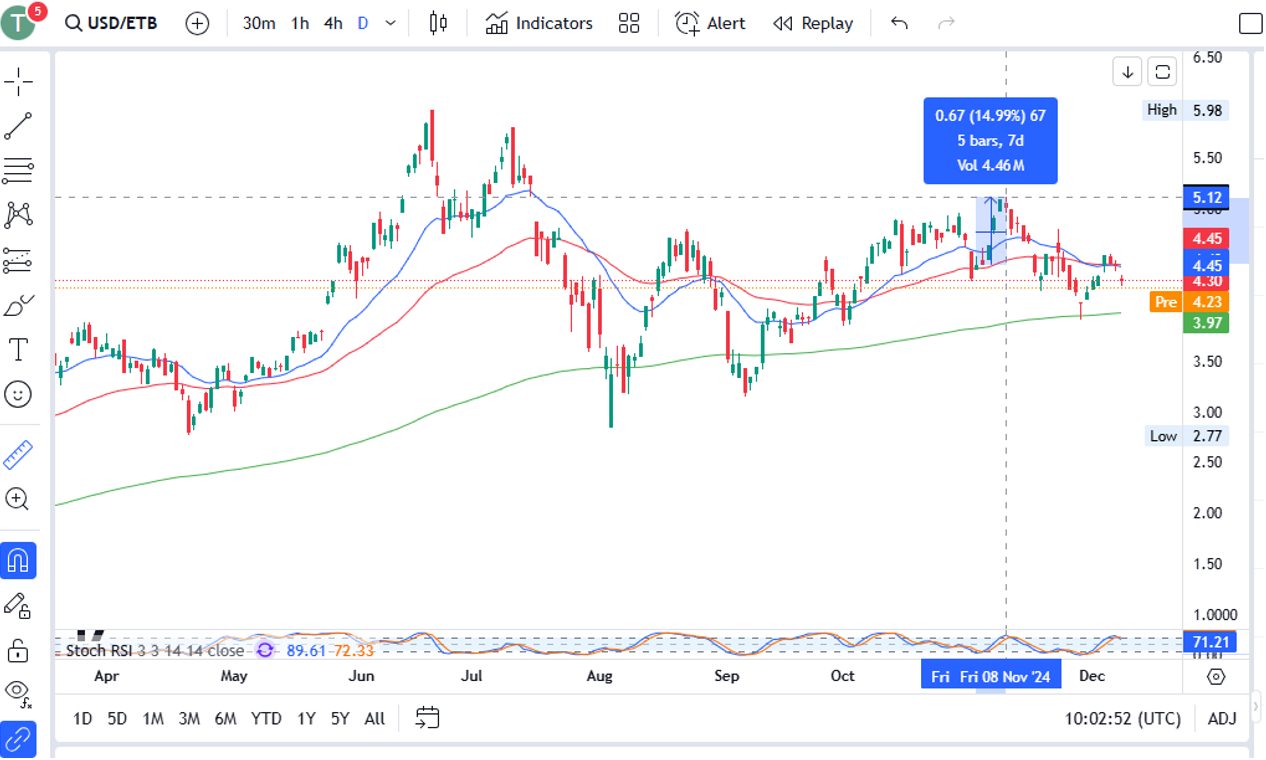CFD Trading In Ethiopia



How would you like to trade African and global financial markets like stocks and commodities without owning the actual assets? Contracts for difference (CFDs) allow Ethiopian traders to access various markets with flexibility.
This beginner’s guide to CFD trading in Ethiopia unpacks the essentials, outlining regulations, risks, opportunities, and taxes, before walking through an example trade on Ethiopia’s currency.
Quick Introduction
- A contract for difference is an agreement to exchange the difference in the price of an asset between the opening and closing of a trade, for example, a stock listed on the planned Ethiopian Securities Exchange (ESX).
- CFD day traders often use leverage to open larger positions with a modest outlay of, say Ethiopian birr (ETB), amplifying profits but also losses.
- The National Bank of Ethiopia (NBE) regulates Ethiopia’s financial sector, but does not yet have specific rules to govern CFD trading, turning many residents to overseas providers.
- Active CFD traders may need to pay tax on trading profits with rates ranging between 10% and 35%, and payments owed to the Ethiopian Revenues Ministry.
Best CFD Brokers In Ethiopia
Based on extensive tests, we’ve determined that these 4 CFD providers are the best for traders in Ethiopia:
How Does CFD Trading Work?
CFD trading means being able to trade an asset without actually owning it. Instead of buying or selling physical gold – a key export for Ethiopia – you can simply speculate on whether the price will go up or down and potentially profit from rising and falling prices.
Using leverage means you can use a small investment to get much bigger exposure to the market than your initial trade deposit.
Unlike some regions, such as Europe and Australia, where leverage is restricted to 1:30 for retail traders, Ethiopia does not have strict rules concerning the level of leverage available to retail traders.
This means you may be able to access leverage as high as 1:1000 or more, which increases both the potential for substantial profits and the risk of significant losses.
What CFDs Can I Trade?
The variety of CFD trading options available will depend on the broker you choose, but Ethiopians may find the following markets of interest:
- Stock CFDs: Trade CFDs on stocks like Dashen Bank, Ethio Telecom, or East African Holding, which is involved in food production and distribution – industries of key importance in Ethiopia. Alternatively, stocks from major US, European and Asian markets are widely supported.
- Commodity CFDs: Gain exposure to key Ethiopian commodities such as coffee, gold, oil, vegetables, and flowers, which are central to the country’s economy and export markets.
- Forex CFDs: Trade major currency pairs such as EUR/USD and GBP/USD, as well as minor and exotic pairs. Ethiopian birr (ETB) pairs, including USD/ETB, EUR/ETB, and GBP/ETB, may attract local traders interested in the dynamics of the Ethiopian economy. However, these may have wider spreads and aren’t commonly available on online trading platforms in our research.
- ETF CFDs: You can access ETFs with Ethiopian exposure, such as the JP Morgan USD Emerging Markets 1-10 Year Bond, XEMD – BondBloxx ETF Trust, and the BondBloxx USD High Yield Bond Energy Sector ETF, offering opportunities tied to emerging market trends, including those impacting Ethiopia.
- Crypto CFDs: Engage in trading CFDs on cryptocurrencies such as Bitcoin and various altcoins, without the need to physically purchase and safeguard digital tokens.
- Index CFDs: Indices with Ethiopian exposure are relatively rare, but traders can explore global indices such as the US Dow Jones or UK FTSE 100. These offer opportunities to trade on broader market movements, especially if local index CFDs are not available.
Is CFD Trading Legal In Ethiopia?
The National Bank of Ethiopia (NBE) regulates banking, foreign exchange, and other financial activities, but focuses on stability rather than actively overseeing a securities market.
The planned introduction of the Ethiopian Securities Exchange (ESX) will allow individuals to buy and sell equities, bonds, and other financial instruments on a regulated platform. However, comprehensive rules concerning CFD trading could be some way off.
Is CFD Trading Taxed In Ethiopia?
The tax environment is developing alongside the planned launch of the Ethiopian Securities Exchange, but currently, any income generated from retail trading is considered income tax under current legislation.
Tax rates range from 10 to 35%, depending on your total earnings.
Given that the tax landscape is still evolving in Ethiopia, I suggest consulting a local tax professional who is familiar with the latest regulations. This will help ensure you pay any taxes due on profits from CFD trading.
A Trade In Action
To bring CFD trading in Ethiopia to life, here is an example of a USD/ETB trade using the leveraged derivative.
Analysis
As a technical trader, I use the momentum bounce strategy for day trading on lower timeframes buying or selling a CFD when its price rises or falls to a support level or shows signs of reversing. The aim is to profit from short-term corrections or “bounces.”
Using the 20-day moving average as a support or resistance level, I go long or short when price action rebounds off this indicator.
I also use stochastics, the 200, 50, and 20-day simple moving averages, and trend lines to time trades and identify support and resistance levels.

Entry And Exit
With the daily, 4-hour, and 1-hour timeframes all correlating and, in a downtrend, I identified key support and resistance levels and executed my trade on the 1-hour chart for a tighter entry and smaller stop-loss order.
With price action breaking through the 20-day moving average, I entered the trade at 4.65 and exited at 5.00 in profit.
Personally, I won’t risk more than 1% of my account on any CFD trade and make use of a stop-loss order to manage potential losses and set take-profit orders to exit the trade once my target is reached.
Bottom Line
CFD trading can allow Ethiopian traders access to global financial markets, opening up trading opportunities beyond its borders.
That said, leverage carries significant risks due to market volatility. If you want to trade CFDs, make sure you have a clear strategy and strong risk management rules, never risking more than you can afford to lose.
To get started, browse DayTrading.com’s choice of the top CFD day trading platforms.
Recommended Reading
Article Sources
The writing and editorial team at DayTrading.com use credible sources to support their work. These include government agencies, white papers, research institutes, and engagement with industry professionals. Content is written free from bias and is fact-checked where appropriate. Learn more about why you can trust DayTrading.com



